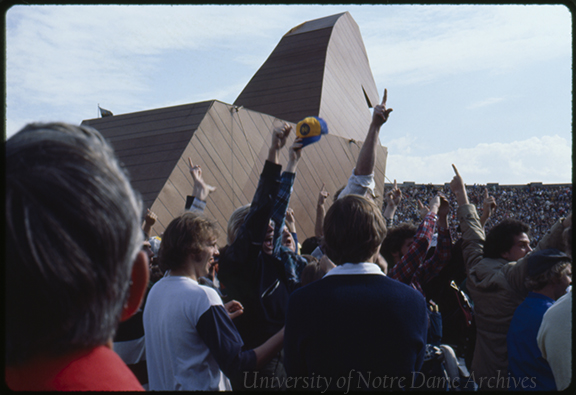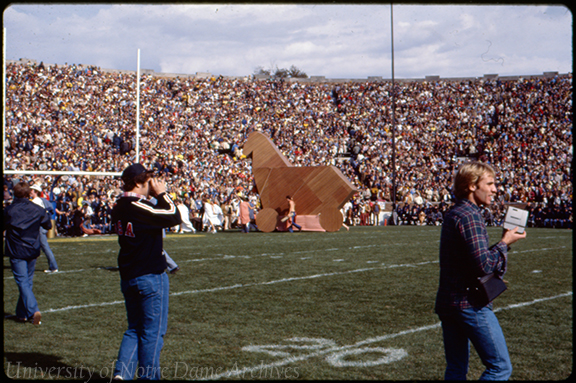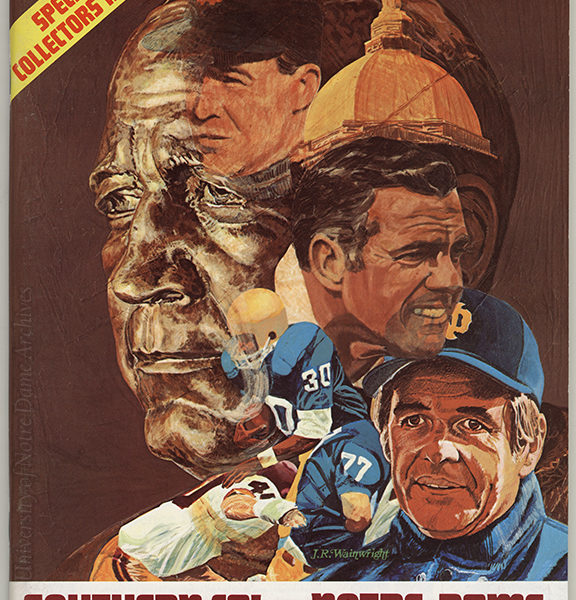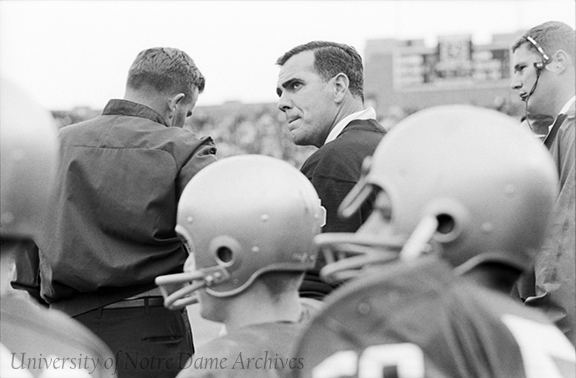

The 1977 game versus the University of Southern California is one of the most legendary games in the history of Notre Dame football all because of the color green. After warming up in the tradition blue jerseys, the team went back into the locker room to find green jerseys hanging in every locker. “Suddenly, the locker room looked like we had just won the National Title and the game hadn’t even started,” cornerback Ted Burgmeier wrote in the 1978 Dome yearbook.
The players’ excitement at the change in jerseys was magnified by the crowd’s reaction once the players came out of the tunnel and on to the field. The return to green jerseys recalled some of the programs best years under coach Frank Leahy and heralded the promise of the 1977 season.
Irish coach Dan Devine had thought about using green jerseys since he arrived at Notre Dame for the 1975 season, but hadn’t yet seized the opportunity. The importance of facing fifth-ranked USC at home in 1977 led him to make the switch. While a few coaches and others knew about the green jerseys for this game, the secret was well kept. However, the players and fans were given many hints during the week leading up to the game.

At the Friday practice before the game tennis coach Tom Fallon sang several Irish ballads to the players, including “The Wearin’ of the Green.” Coach Devine followed with stories about the plight of Irish immigrants and their struggles in America. Later that night at the pep rally, Irish basketball coach “Digger” Phelps introduced a new cheer — “We are . . . the Green Machine.” The players were none the wiser despite all of the hints.
Pregame activities included rolling a student-constructed Trojan horse into the tunnel and out on to the field. The horse was fifteen feet high and had room for a small number of students who were dressed as football players. The student-inspired Trojan horse recalled earlier days when pregame activities came up from the students, including parades, snake dances, bonfires, floats, and dorm decorations. Some were planned, such as the Trojan horse, while others were more spontaneous.

Over the years, the 1977 USC game has become known as much for the Trojan horse as for the green jerseys. The game is often referred to as the “Green Jersey Game,” however, in celebration of the 40th anniversary of the game in 2017, the Notre Dame Bookstore is selling a commemorative tee-shirt with the words “Trojan Horse Game.”

Coach Devine had correctly predicted the excitement in the locker room before the game against a long-time rival. In his post-game comments he said, “I didn’t even go in the there. I had nothing to say. Everything had been said.” As the players exited the locker room, the Trojan sideline was confused, wondering if the green jerseys were being worn by students leading the team out of the tunnel. The Irish had not beaten the Trojans since 1973, and the eleventh-ranked Notre Dame team had already lost a game to Mississippi early in the season. USC, ranked fifth going into the Notre Dame game, also had one loss. The Trojans were favored by seven points.

The pregame excitement carried over into the game with the Irish dominating on both sides of the ball. Burgmeier noted, “in order to win, we needed the help of the student body, and that we got.” Quarterback Joe Montana ran for two touchdowns and threw for two more. Linebacker Bob Golic blocked a punt and defensive end Jay Case ran it back for a touchdown. A bobbled extra point try ended up as a two point conversion for the Irish. The Notre Dame defense pressured the USC quarterback into three interceptions. The final score was 49 to 19.

After the game Coach Devine commented, “It was a team victory in every sense of the word.” The Irish went on the win the remainder of their games, including a 38 to 10 victory over the Texas Longhorns in the Cotton Bowl. The Cotton Bowl win gave the Irish the national championship.






